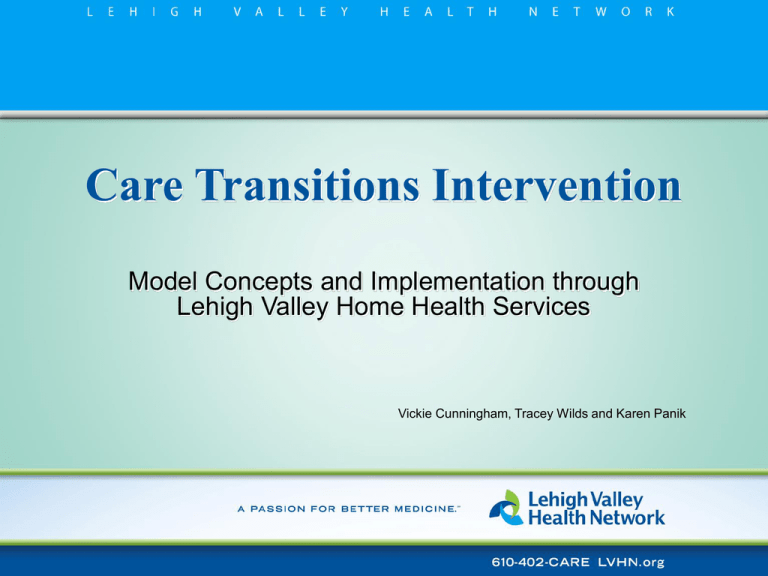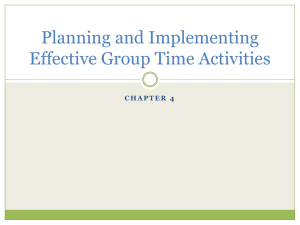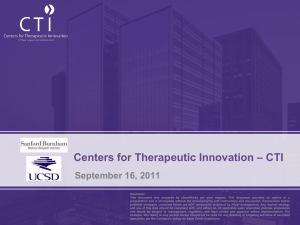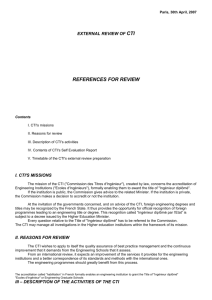Care Transitions Intervention - Pennsylvania Homecare Association
advertisement

Care Transitions Intervention Model Concepts and Implementation through Lehigh Valley Home Health Services Vickie Cunningham, Tracey Wilds and Karen Panik "Sometimes the questions are complicated and the answers are simple." -Dr. Seuss What is the Care Transitions Intervention (CTI)? ■ ■ ■ ■ ■ 4-week program Patients with complex care needs and family caregivers Specific tools Transition Coach Self-management skills Why The Care Transitions Intervention? ■ Patients who received this program were significantly less likely to be readmitted to the hospital, and the benefits were sustained for five months after the end of the one-month intervention. ■ Anticipated cost savings for 350 chronically ill adults with an initial hospitalization over 12 months is $295,594. ■ Patients who received this program were also more likely to achieve self-identified personal goals around symptom management and functional recovery. CTI Model Pillars ■ ■ ■ ■ Medication self-management Use of a dynamic patient-centered record, the Personal Health Record Timely primary care/specialty care follow up Knowledge of red flags that indicate a worsening in their condition and how to respond CTI Model Encounters ■ ■ ■ Hospital Visit Home Visit 2-3 phone contacts Key Attributes of a Coach Ability to shift from a “doing” role to a coaching role ■ Comfort with medication review ■ Understands the difference between being persistent vs. pesty ■ Outcomes Obtained in Initial study ■ Re-hospitalized 180 days – 26 % Intervention 31 % control ■ Re-hospitalized 90 days – 17 %Intervention 23 % control ■ Re-hospitalized 30 days – 8 % Intervention 12 % control Coleman, E.A., Parry, C, Chalmers, S., & Min, S. (2006). The care transitions intervention results of a randomized control trial. Archives of Internal Medicine 166 1822-1828. Care Transitions Intervention Implementation at Lehigh Valley Health Network Market Analysis Strengths • CTI has been researched and was touted by Medicare Innovations Collaborative (Med-IC) as one mechanism to enhance older adult patient care while decreasing rehospitalization (Medicare Innovations Collaborative, 2011). • Patient transition to home from acute setting can be fragmented and difficult to navigate • If patient does not require traditional home based services the patient may feel insecure about the transition to home and return to the hospital creating avoidable readmission Medicare Innovations Collaborative (2011). Models of Care – Transitional care. Retrieved from http://www.medic.org/pages/care.html Market Analysis Continued Weaknesses – Need for systematic culture change within healthcare delivery system – Research has not been duplicated by anyone other than originator Market Analysis Continued Opportunities • No current transitions program to assist patients that do not receive traditional home based services within Lehigh Valley Health Network • No current transitional care delivery programs within geographic area (Lehigh, Carbon, Northampton County) Market Analysis Continued Threats – Lack of patient interest – Lack of direct revenue which could impact sustainability Market Analysis continued Stakeholders – Acute care hospitals who wish to decrease uncompensated care – Home health agencies who wish to enhance home and community based services – Third party payers who wish to decrease care delivery costs – Patients and caregivers who wish to improve patient self management – Physicians who wish to boost patient compliance with treatment plans Goals ■ ■ ■ ■ Ease transition from other levels of care to home based services Enhance collaboration and transitions between home based service programs. Improve continuity of care to patients with chronic disease. Decrease number and length of hospitalizations for patients with chronic disease Setting the Stage ■ ■ ■ ■ Evaluate all transitions program evidence Training for care transitions coaching Development of patient materials including admission packet, Policies, consent, documentation and patient education Spoke with Members of the MED- IC initiative for guidance on roll out Setting the Stage Cont. ■ ■ ■ ■ ■ ■ ■ Small test of change using Coleman model Evaluation of pilot and obtained grant funding for Transitions Coach position Developed job description Coach hired Developed referral mechanism using Allscripts system Developed home health mechanism for referrals Identified Inclusion Criteria Inclusion Criteria ■ ■ ■ ■ ■ ■ ■ Lehigh and Northampton Co Hospitalized Telephone English Speaking Adult Alert and Oriented At least 1 chronic condition Service Delivery Plan Follow criteria outlined by the CTI to reduce rehospitalization – 4-week program – Patients with complex care needs and family caregivers – Specific tools (Personal Health record) – Transition Coach – Self-management skills Care Transitions Program (2007). Business plan. Retrieved from Colorado_Business_Plan_2009.pdf Service Delivery Plan Continued ■ ■ 1 FTE Transitions coach per 25 patient caseload (RN or MSW preferred) 0.25 FTE Clerical /office support per 25 patient caseload Outcomes CTI Outcomes 1/12/2011 – 3/2012 ■ ■ ■ ■ ■ Total referrals: 219 93 Refusals 46 Referral Inappropriate 75 Enrolled (signed a consent of willingness to CTI participation) 30 day readmission 10.6% overall – 0% of those who completed intervention admitted 30 days post completion Cost Benefit Analysis $265 per day to maintain program average cost of heart failure readmission = $5497 (Whelan, Greiner, Schulman & Curtis, 2010, p.37) Prevention of 18 hospitalizations for HF per year will recoup cost of program Cost Benefit Analysis Continued • 30 day readmission projection • 365 patients per year at 12 % rehospitalization rate = 44 patients rehospitalized • 365 patients at 8% rehospitalization rate = 29 patients rehospitalized • 16 patient decrease = $87,952 annualized savings • 90 day readmission projection • 365 patients per year at 23% rehospitalization rate = 84 patients rehospitalized • 365 patients at 18% rehospitalization rate = 62 • 22 patient decrease = $120,934 annualized savings Coleman, E.A., Parry, C, Chalmers, S., & Min, S. (2006). The care transitions intervention results of a randomized control trial. Archives of Internal Medicine 166 1822-1828. Barriers ■ Difficult to get patients to accept program – Overwhelmed – Don’t need – Have support Lessons Learned ■ ■ ■ ■ ■ Identify as a component of delivery system Enhanced visibility in community If developing other models that are similar keep CTI data separate Work with care providers in other arenas to enhance program Work with PCP and hospitalists together and separate to enhance buy – in Patient Perception “Thank you for visiting me in my home…this is a good, helpful program“ " It's so nice to have all this support to keep me in the comfort of my home" “Really helps me understand what my medications are and if I need to talk to the Doctor about them” “Thanks for helping me feel more confident in making my doctor appts” "Thank you so much for your time, concern and patience…I've never had this kind of support" Conclusions ■ ■ ■ CTI increases patient self management CTI decreases hospital readmissions CTI cost effective and simple to implement References ■ ■ ■ ■ ■ ■ ■ ■ ■ ■ Boling, P.A., (2009). Care transitions and home health care. Clinical Geriatric Medicine 25 135-148. Care Transitions Program (2007). Business plan. Retrieved from Colorado_Business_Plan_2009.pdf Care Transitions Program (2007). CTI Evidence and Adoptions. Retrieved from http://www.caretransitions.org/documents/Evidence_and_Adoptions_2.pdf Coleman, E.A., Parry, C, Chalmers, S., & Min, S. (2006). The care transitions intervention results of a randomized control trial. Archives of Internal Medicine 166 1822-1828. Coleman, E.A., Smith, J.D., Frank, J.C., Min, S. Parry, C. & Kramer, A.M. (2004). Preparing patients and caregivers to participate in care delivered across settings the care transitions intervention. Journal American Geriatric Association 52 1817-1825. Colorado Foundation for Medical Care (2010). About the theme: opportunities for improving care transitions. Retrieved from http://www.cfmc.org/caretransitions/about.html Jencks, S.F., Williams, M.V. & Coleman, E.A. (2009). Rehospitalizations among patients in the Medicare fee-for-service program. The New England Journal of Medicine 360(14) 1418-1428. Medicare Innovations Collaborative (2011). Models of Care – Transitional care. Retrieved from http://www.med-ic.org/pages/care.html Parrish, M.M, O’Malley, K., Adams, R.I., Adams, S.R. & Coleman, E.A. (2009). Implementation of the care transitions intervention sustainability and lessons learned. Professional Case Management 14(6) 282-293. Whelan, D.J., Greiner, M.A., Schulman, K.A., & Curtis, L.H. (2010) Costs of inpatient care among Medicare beneficiaries with heart failure, 2001 to 2004. Circ Cardiovasc Qual Outcomes 3 33-40. Contact Information: vickie.cunningham@lvh.org tracey_awilds@lvh.org Questions?










